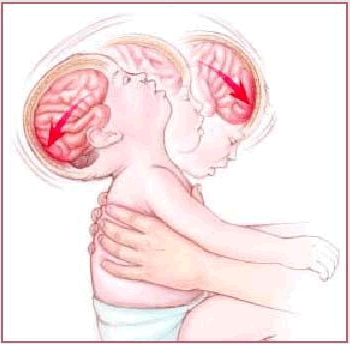 The term “shaken baby syndrome” (SBS) was developed to explain those instances in which severe intracranial trauma occurred in the absence of signs of external head trauma. SBS is the severe intentional application of violent force (shaking) in one or more episodes, resulting in intracranial injuries to the child. Physical abuse of children by shaking usually is not an isolated event. Many shaken infants show evidence of previous trauma.
The term “shaken baby syndrome” (SBS) was developed to explain those instances in which severe intracranial trauma occurred in the absence of signs of external head trauma. SBS is the severe intentional application of violent force (shaking) in one or more episodes, resulting in intracranial injuries to the child. Physical abuse of children by shaking usually is not an isolated event. Many shaken infants show evidence of previous trauma.
Frequently, the shaking has been preceded by other types of abuse.
Mechanism of Injury
The mechanism of injury in SBS is thought to result from a combination of physical factors, including the proportionately large cranial size of infants, the laxity of their neck muscles, and the vulnerability of their intracranial bridging veins, which is due to the fact that the subarachnoid space (the space between the arachnoid membrane and the pia mater, which are the inner two of the three membranes that cover the brain) are somewhat larger in infants. However, the primary factor is the proportionately large size of the adult relative to the child. Shaking by admitted assailants has produced remarkably similar injury patterns:
- The infant is held by the chest, facing the assailant, and is shaken violently back and forth.
- The shaking causes the infant’s head to whip forward and backward from the chest to the back.
- The infant’s chest is compressed, and the arms and legs move about with a whiplash action.
- At the completion of the assault, the infant may be limp and either not breathing or breathing shallowly.
- During the assault, the infant’s head may strike a solid object.
- After the shaking, the infant may be dropped, thrown, or slammed onto a solid surface.
- The last two events likely explain the many cases of blunt injury, including skull fractures, found in shaken infants. However, although blunt injury may be seen at autopsy in shaken infants, research data suggest that shaking in and of itself is often sufficient to cause serious intracranial injury or death.
Questionable convictions in “shaken baby” cases?
Deborah Tuerkheimer is a Professor of Law at Northwestern University and the author of “Flawed Convictions: ‘Shaken Baby Syndrome’ and the Inertia of Injustice.” She also appears onSaturday’s “48 Hours” investigation into the case of Melissa Calusinski, a former day care provider who says she is wrongfully convicted in a toddler’s death. Here, Tuerkheimer weighs in on questionable convictions in child death cases. Her opinions do not necessarily reflect those of CBS News.
A few months ago, a 55-year-old Florida day care provider became yet another caregiver accused of shaking a toddler to death. The woman, who had worked with children for decades, denied harming the boy. But pediatricians concluded that this was a case of Shaken Baby Syndrome (SBS).
Even before an autopsy was performed, the state charged the woman with murder. She is being held in jail without bond and if convicted, she faces mandatory life in prison without the possibility of parole.
Based on the press reports, this case resembles many that I have written about in my book, Flawed Convictions: “Shaken Baby Syndrome” and the Inertia of Injustice. Without witnesses or external signs of abuse, the classic diagnosis of Shaken Baby Syndrome rests on three neurological symptoms, otherwise known as the “triad”: bleeding beneath the outermost layer of the brain, retinal bleeding, and brain swelling.
These symptoms are said to prove that a baby was violently shaken and, what’s more, to identify the abuser– whoever was present when the child was last lucid. Shaken Baby Syndrome is, in essence, a medical diagnosis of murder. In order to convict, prosecutors must rely entirely on the claims of science.
But the science has shifted. In recent years, there has been a growing consensus among experts that the neurological symptoms once viewed as conclusive evidence of abuse may well have natural causes, and that old brain injuries can re-bleed upon little or no impact.
In short, current science raises significant questions about the guilt of many caregivers convicted of shaking babies.
Reflecting real movement in the direction of doubt, this past spring, a federal judge in Chicago issued a ruling of “actual innocence” in the case of Jennifer Del Prete, a caregiver accused of shaking a baby in her care. (My book describes this trial in detail.) Del Prete was able to show that, based on what doctors now know about alternative causes of the triad, no reasonable jury could possibly find Del Prete guilty of murder. Indeed, according to the reviewing judge, a lack of evidentiary support for the theory of Shaken Baby Syndrome means that the diagnosis is arguably “more an article of faith than a proposition of science.”
Our legal system has been slow to absorb this new reality. As a consequence, innocent parents and caregivers remain incarcerated and, perhaps more inexplicably, prosecutions based solely on the “triad” symptoms continue even to this day. The cautionary tale of Shaken Baby Syndrome shows that our system is too inclined to stay the course, and awful injustices can result.
